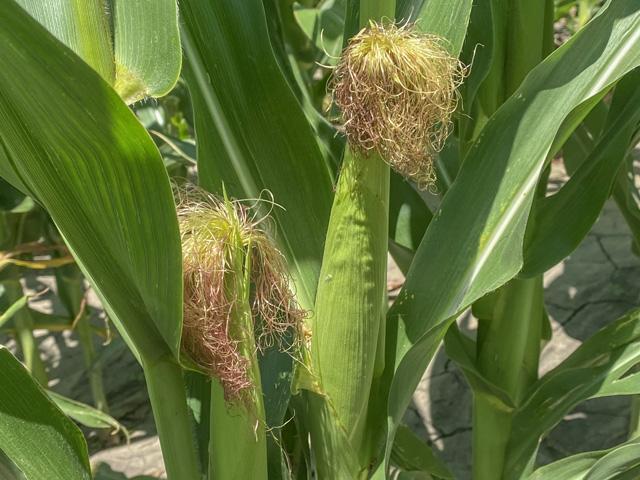Lowering Crop Production Emissions
EWG: Common Practices Can Reduce GHG Emissions From Corn Production
OMAHA (DTN) -- Environmental Working Group is touting six farming practices in the Corn Belt the group says could greatly reduce nitrous oxide emissions in crop production.
EWG also wants to ensure $19.5 billion in funding for USDA conservation practices in the Inflation Reduction Act is not cut when Congress gets down to writing the next farm bill. The group instead wants to see more incentives go to practices that reduce emissions and sequester carbon.
Using USDA's Carbon Management and Emissions Tool, or COMET-Planner, EWG cited farmers in 11 Midwest and Plains states could reduce nitrous oxide emissions by more than 4 million tons through more aggressive use of rotating crops, planting cover crops, reducing tillage practices and adding more grass strips and trees on their farms.
Scott Faber, senior vice president of government affairs at EWG, said the group chose practices that farmers are already applying in a lot of areas. A key, however, is ensuring there is funding in the conservation programs that will incentivize more farmers to use these practices.
"We also have the best practices that could be used specifically on cornfields," Faber said.
Nitrous oxide accounts for 6% of all U.S. greenhouse emissions, according to EPA, but 1 ton of nitrous oxide has the same impact on the atmosphere as 265 tons of carbon dioxide. Nitrogen-based fertilizers accounted for about 73% of U.S. nitrous oxide emissions in 2021.
Overall, agriculture accounts for about 11% of U.S. greenhouse emissions, a percentage that could rise if agriculture does not keep pace with other sectors of the U.S. economy in lowering GHG emissions.
P[L1] D[0x0] M[300x250] OOP[F] ADUNIT[] T[]
EWG has cited that only 23% of funds from the Environmental Quality Incentive Program (EQIP) and just 5% of the Conservation Stewardship Program (CSP) went to climate-smart practices from 2017-2020.
"There are a lot of practices that are getting significant funding that really provide little or no benefit to the climate, at a time when ag's share of greenhouse gas emissions is growing," Faber said.
Over the past year, USDA has signed agreements with farm groups and businesses under the Partnership for Climate-Smart Commodities for $3.1 billion in funding from the Commodity Credit Corp. to incentivize some of the same cropping practices spotlighted by EWG.
USDA also received a $19.5 billion funding boost in the IRA for its conservation programs that also is meant to boost practices that sequester carbon in the soil or reduce greenhouse gases from agriculture.
A debate continues among members of the House and Senate agriculture committees over whether some of that funding will be shifted in the farm bill, or language is added that would not require emission reductions or carbon sequestration for farmers to receive some of that IRA money.
Pointing to the broad participation from farm groups in the Partnership for Climate-Smart Commodities, EWG maintains farmers nationally would lose funds if Congress were to shift conservation funding to programs that help with price supports such as in the commodity title of the farm bill.
"Farmers are lining up around the block to help address the climate crisis," Faber said. "So, it would be a tragedy to turn farmers away in order to increase price guarantees for cotton, rice and peanut farmers. That's what it boils down to at the end of the day is whether we're going to help all farmers when they take steps to address the climate crisis or help a few farmers by raising their reference prices."
Last week, USDA announced $300 million will go to ramp up "measurement, monitoring, reporting and verification" of greenhouse gas emissions and carbon sequestration on farms and private forests as well. That funding also came from the IRA.
The 11 states cited by EWG include Illinois, Indiana, Iowa, Kansas, Michigan, Minnesota, Nebraska, North Dakota, Ohio, South Dakota and Wisconsin. Combined, those states account for more than 78% of planted corn acreage this year, according to USDA's June Acreage report.
EWG noted the same practices that reduce nitrous oxide emission also provide other benefits such as improved water quality and increased wildlife habitat.
"Corn farmers are not the only farmers who can help tackle the climate crisis," EWG stated, adding, "But 65% of nitrogen fertilizer is used to grow corn, so conservation practices implemented on farmland used to grow corn can make a big dent in agricultural nitrous oxide emissions."
USDA COMET-Planner: http://comet-planner.com/…
EPA data on U.S. greenhouse gas emissions: https://www.epa.gov/…
Also see "USDA Unveils $300 M Greenhouse Gas Measurement, Monitoring Plan" here: https://www.dtnpf.com/….
Chris Clayton can be reached at Chris.Clayton@dtn.com
Follow him on Twitter @ChrisClaytonDTN
(c) Copyright 2023 DTN, LLC. All rights reserved.



